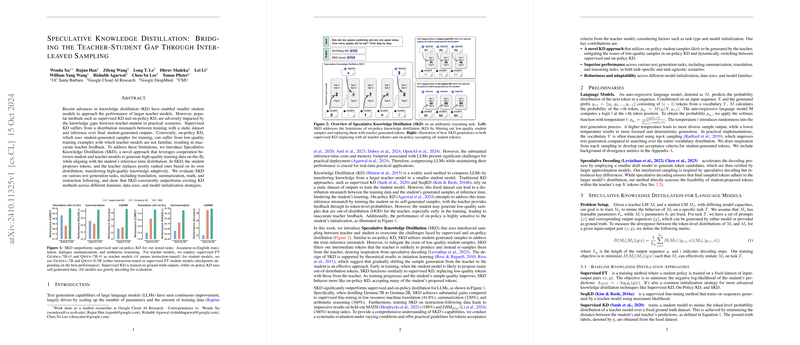Overview of "Speculative Knowledge Distillation: Bridging the Teacher-Student Gap Through Interleaved Sampling"
The paper, "Speculative Knowledge Distillation: Bridging the Teacher-Student Gap Through Interleaved Sampling," addresses critical limitations in the field of Knowledge Distillation (KD) for LLMs. The authors propose Speculative Knowledge Distillation (SKD), a method designed to enhance the efficacy of KD by improving the interaction between teacher and student models through interleaved sampling. This approach aims to overcome significant challenges associated with supervised and on-policy KD methods.
Key Contributions
The primary contribution of the research is the introduction of the SKD framework, which leverages interleaved sampling to enhance the quality of on-the-fly training data. This is achieved by adapting speculative decoding strategies to dynamically filter and replace low-quality student-generated tokens with those proposed by the teacher model. This technique helps to minimize the knowledge gap, ensuring that the training process aligns more closely with inference-time conditions.
Numerical Results and Evaluation
The effectiveness of SKD is demonstrated across a variety of text generation tasks, including translation, summarization, arithmetic reasoning, and instruction following. The numerical results indicate that SKD significantly outperforms traditional KD methods:
- Translation: SKD achieved a COMET score improvement of 41.8% above baseline methods.
- Summarization: The ROUGE-L metric showed a 230% improvement.
- Arithmetic Reasoning: SKD increased accuracy by 160%.
These results underscore the robustness of SKD across different data sizes, model initializations, and domains. By refining the training data quality through interleaved sampling, SKD consistently delivered superior performance.
Implications and Future Directions
The advancements introduced by SKD have both practical and theoretical implications for AI and LLM deployment. Practically, SKD provides a viable pathway for deploying smaller, yet high-performing, models in environments where computational resources are limited. Theoretically, it offers insights into more effective learning dynamics between teacher and student models, suggesting the merits of adaptable, feedback-oriented training paradigms.
Future work could explore the scalability of SKD to even larger model architectures or its integration with reinforcement learning strategies for further optimization. Additionally, the exploration of task-agnostic KD through SKD opens potential for broader applications across diverse subfields within AI.
In conclusion, SKD presents a substantial advancement in KD methodologies, offering a strategic approach to effectively distill knowledge while maintaining performance efficiency. This research contributes meaningfully to the landscape of model compression and knowledge transfer in AI, presenting a robust framework for future exploration and improvement.
